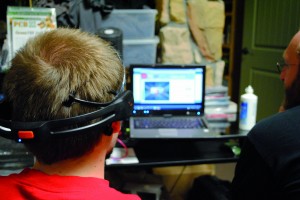SATURDAY, 29 JANUARY 2011
Computer game controller design has seen a recent move away from buttons and joysticks towards more naturalistic input using motion sensors and voice recognition. The next step could be even more revolutionary and would not require any movement at all—simply an active brain.The technology behind this control scheme—electroencephalography (EEG)—is not new. Electrical activity in the brains of animals was reported first in the 19th century by Liverpudlian Richard Caton. Since then, the science has developed steadily. Present day EEG kits use scalp electrodes connected to a laptop. These electrodes detect the electrical activity of neurons in the brain, giving feedback to researchers on when, where and how the brain is working.
A recent trend in EEG research has been the creation of brain-computer interfaces (BCIs). BCIs use the brain’s electrical activity to carry out simple tasks such as controlling a cursor on a screen, spelling out a word or moving a paddle in a game of pong. The development of these schemes requires a training phase during which a computer learns to recognise the patterns that the brain produces as an individual thinks about different things. Alternatively, users can train themselves to change their brain states in ways the computer can interpret. For example, increasing their concentration to make an avatar rise on the screen and relaxing to make it drop again.
In recent years, this technology has been brought out of the lab and into the consumer market by dedicated producers such as Emotiv, NeuroSky and OCZ. In order to make them affordable and easy to use, these companies have stripped down EEG research systems to their essentials. Unlike research sets, these do not require extensive scalp and electrode preparation and use fewer electrodes. They are also considerably cheaper, with some sets selling for less than 100 pounds. It is thus no surprise that game manufacturers are starting to look on with interest.
Although games using this technology are already on the market, they are not nearly as complex as modern console releases. Mindflex invites users to steer a ball around an obstacle course with their mind, while Star Wars Force Trainer allows users to emulate Jedi ‘force’ tricks by using their minds to control a fan whose motion causes a ball to lift. Recently, household names have invested in developing the technology further. Microsoft Research is working on bringing low-cost brain-computer interfaces to the masses and Square Enix, makers of the popular Final Fantasy series of computer games, have started to develop a game with EEG controls.
Not everyone is convinced, however, that these devices will be a gaming success. EEG experts point out that these cheap devices are not as capable of filtering out noise as research set-ups. In particular, electrical signals from scalp and facial muscle movements are likely to drown out true brain signals. Even if this problem is solved, researchers suggest that to make these systems work reliably, users have to be prepared to put a lot of time into optimising electrode placement and usage, and into training both computers and their own brains to ‘communicate’ effectively. For a generation of computer gamers accustomed to quick hits and instant gratification, this may be too much work.
Instead, it may be that the greatest beneficiaries of the consumer-EEG movement will be those most motivated to put time and effort into making them work. For patients with locked-in-syndrome or those with motor disabilities, the ability to communicate with their mind or control a wheelchair or prosthetic, could immeasurably improve their quality of life.
The time and intellectual investment required to train one’s brain to communicate with a computer may prove too much for the casual gaming market. However, gaming’s flirtation with EEG will leave a legacy of cheaper, easier to access brain-control technologies for those who really need it. No matter how many of us end up brain-gaming, it will not be a wasted venture.
Tom Ash is a PhD student in the Department of Clinical Neurosciences

